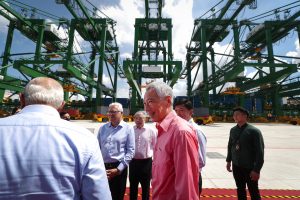China has been home to the world’s busiest container ports for over a decade. Densely clustered along the eastern seaboard, they ship an array of goods, from smartphones and computers to clothes and household appliances, to the global market. Last year, Shanghai alone processed 47 million TEU, more cargo than the top ten U.S. ports combined.
But an old rival may be quietly catching up.
Singapore unveiled Phase 1 of Tuas Port this year with the long-term goal of building a consolidated hub for the global shipping industry. A decade in the making, the $20 billion terminal is designed to handle 65 million TEU per year by around 2040.
“We are going full steam ahead,” said Prime Minister Lee Hsien Loong, who inaugurated the project in September. Loong lifted and loaded a container remotely to demonstrate how automation had simplified what was once a physically demanding task. The berths, built on reclaimed land, will be manned by drones and driverless vehicles. The design is well suited for Singapore’s conditions, given its perennial land and labor shortages. Chee Hong Tat, a senior minister of state for transport, told Parliament that a tech-centric focus was critical: “If we don’t stay ahead of the competition, others will steal our lunch.”
The launch of Tuas Port comes during a period of turmoil in the container shipping world. China’s “zero COVID” policy scrambled supply chains this year. The aftereffects are still reverberating through the system. A satellite photo taken on April 19 showed nearly 500 ships off the coast of Shanghai unable to dock. The gridlock at sea was a direct consequence of a virtual shutdown of trucking post-lockdown. Containers piled up on the docks with no workers or trucks to clear the logjam.
One of the companies affected was Apple subcontractor Pegatron. A tech industry analyst told the BBC that the temporary closure of the Shanghai-based iPhone assembly plant would “throw gasoline on the raging fire which is the supply chain for Apple.” Soon after the shutdown, Pegatron and other iPhone assemblers indicated they would move some production lines to Vietnam, Indonesia, and India.
The pivot to Southeast Asia could be an opportunity for Singapore. With a population of only 5.6 million, the city-sized nation is hardly in a position to compete with China’s “gateway ports” on export volumes. But the southern tip of the Malay Peninsula has a long history of serving as the primary transshipment hub for regional cargo, aggregating containers from ASEAN neighbors like Vietnam and Indonesia. About 85 percent of the incoming cargo is destined for other ports. Singapore is also an essential stop on the maritime energy trade route, refining crude oil for China, Australia, and Indonesia. Notably, the port’s location along the narrow Strait of Malacca, an oil industry “choke point,” gives the city-state a degree of geostrategic leverage.
Singapore is vulnerable to these maritime “choke points” as well. More than 90 percent of the food supply is imported. Malaysia is the leading land-based supplier, but other items, including frozen chicken, arrive in shipping containers from Brazil. Tankers bring in 70 percent of the country’s natural gas, which powers its electricity plants. “Singapore always looks at the world from a position of acute vulnerability,” Foreign Minister Vivian Balakrishnan said at an event on the sidelines of the United Nations General Assembly this year.
The plans for Tuas were set in motion in 2012, two years after Singapore lost its top port status to Shanghai. Building a mega port in anticipation of demand seemed like an unwise proposition at the time. China already had seven ports among the top ten and was financing maritime Belt and Road projects across Southeast Asia. Hong Kong, a leader in transshipment, appeared poised to profit from the explosive growth of container shipping in China.
However, Belt and Road port projects like the Melaka Gateway in Malaysia, built to challenge Singapore, have yet to live up to expectations. Hong Kong missed the boat (literally) as large container ships bypassed Kwai Tsing’s terminals and sailed directly to gateway ports like Shenzhen. “Transshipment in many ways is the poisoned chalice of terminal operations. It’s not as profitable as export/import cargo. It can pack up and leave much more quickly and effortlessly than does domestic cargo,” writes Eric Johnson, a U.S.-based supply chain analyst.
Hong Kong’s decline is a cautionary tale for Singapore.

































